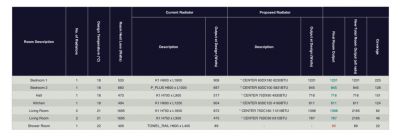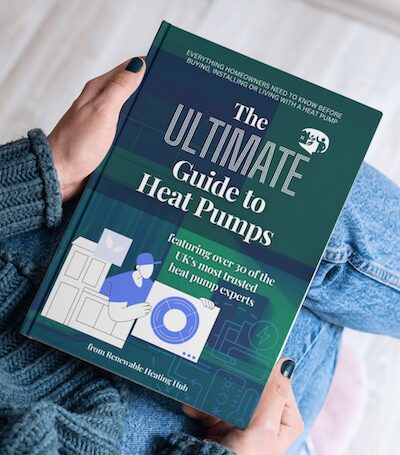British Gas versus Octopus: Two possible heat pump routes - how to evaluate them?
@njt the bathroom is not on there. I'm supplying a 'designer' radiator Octopus just ignored my bathroom.
This is why I'm confused - I have selected a radiator that is 493 watts at delta 30 but now I don't know if that is sufficient as I clearly don't understand how they came up with the rad sizes. Or how I choose one. 🙁
If its the spec from the radiator manufacturer then 'at a deltaT of 50' (or just '50' is likely to mean means when the temperature of the radiator (ie the flow temperature) is 50C higher than the room, ie at a deltaT between radiator and room of 50.
Yikes! So to calculate a radiator to run @ a flow temp of 40º in a room you want to be 21º it's a delta T of 19?
My radiator schedule bears little relationship to the outputs on the manufacturer's website. I have been converting the watts at delta 50 to watts at delta 30 using an online calculator and still can't get it. I'll try delta 20 conversions.
Posted by: @lucia@njt the bathroom is not on there. I'm supplying a 'designer' radiator Octopus just ignored my bathroom.
This is why I'm confused - I have selected a radiator that is 493 watts at delta 30 but now I don't know if that is sufficient as I clearly don't understand how they came up with the rad sizes. Or how I choose one. 🙁
You need to look at the radiator manufacturer's specification, which should state its output at DT50, that is an average water temperature of 70C when the indoor temperature is 20C.
Using the attached radiator output calculator you will be able to predict the likely radiator output at different flow temperatures. The yellow highlighted cells can be changed to obtain results under different operating conditions.
@derek-m I only need to use the left hand side? Apart from the LWT?
For example: if I change indoor temp to 22º for the bathroom then change LWT to 40º then add the heat output @delta 50º what's the other 2 things on the right side?
How do I know the RWT? If I put it at 35º what effect does it have? Or do I ignore that bit?
I'm confused about RWT and the difference between the 2 heat output numbers - the one on the left makes sense if I change the room temp, the LWT and the watts at delta 50º It gives me the correct watts at the specified LWT
But what's the Heat output Watts (yellow right) and RWT where do I get that from? Or is that just for people who want to tweak their systems?
Sorry for the Qs I had a play with this before and was baffled by those bits in the right (apart from LWT). 🙈
I think (please correct me if I'm wrong) a simple, approximate would be to convert the manufacturer's outputs @ delta 50 to delta 20? This would give me a rough idea of heat output at a 40º flow temp?
You can ignore cells G6 and H6, they are just to estimate the required water temperature for a given wattage output. The reverse process so to speak.
As you state cells J1 and J2 are the LWT and RWT respectively, with cell K2 giving the difference.
The amount of thermal energy emitted by a radiator is dependent upon the average water temperature, which should be approximately half way between LWT and RWT. So if the LWT is 50C and RWT is 45C, then the average water temperature displayed in cell C2 is 47.5C. If the RWT were to increase to 46C, the average water temperature would then be 48C, so the radiator would emit slightly more thermal energy.
The actual quantity of thermal energy emitted by an individual radiator will be defined by the average water temperature and the flow rate through that particular radiator. If the flow rate is slower then the water has more time to transfer thermal energy, so the RWT from that particular radiator will likely be lower than other ones. This in turn means that the average water temperature is also lower, so that particular radiator is actually emitting slightly less thermal energy.
The RWT at the heat pump is all the radiator values mixed together.
I forgot to mention that your heating system is dynamic, so it keeps changing and re-balancing. If the OAT starts to increase, then the thermal energy demand is reduced, which in turn would cause the IAT to start to increase. But as the IAT increases the actual output from the heat emitters starts to reduce for a constant LWT and RWT, so the IAT would increase to the point where supply and demand are again balanced.
In practice as the thermal energy demand reduces, the RWT increase is sensed by the heat pump controller, which in turn lowers the LWT in an attempt to maintain a fairly constant IAT.
Posted by: @luciaYikes! So to calculate a radiator to run @ a flow temp of 40º in a room you want to be 21º it's a delta T of 19?
My radiator schedule bears little relationship to the outputs on the manufacturer's website. I have been converting the watts at delta 50 to watts at delta 30 using an online calculator and still can't get it. I'll try delta 20 conversions.
Most radiator manufacturers give a curve for output in the form P=kdeltaT^n
where k is a constant, deltaT is the temp difference between radiator and room, and ^n means to the power of n.
For most passive radiators n=1.3 so output is proportional to deltaT to the power 1.3. Using this formula is close enough for any practical purpose so far as I am aware.
Strictly deltaT should be 'average deltaT'. Just knock 2.5C off of the flow temperature when doing the calculation for a typical design where deltaT across the radiator (at the design OAT/IAT) is ~5C.
Most, but not all, radiator manufacturers quote the output at average deltaT=50. So in your example FT=40, room Temp =21, (average) deltaT=16.5
This means that you need to choose a radiator with a rated output at deltaT50 of (50/16.5)^1.3 =4.2 times the output you want. This ratio is sometimes called the 'oversize factor'. So a 1kW demand requires a radiator rated for 4.2kW.
In a fairly typical radiator setup FT=45, Room temp = 20, deltaT=22.5 leading to an 'oversize factor' of 2.8.
Hope that helps, once you decide your FT you can simply work out the oversize factor to size radiators. No need to look each up.
Finally if your 'designer' bathroom radiator is designed as a towel rail, it is most unlikely to have sufficient output. There is a good argument for putting electric heating in a bathroom because you generally want it hotter than the surrounding areas for a very short period of time. An electric towel rail is one option. Perhaps better however is just put in a 'normal' radiator.
4kW peak of solar PV since 2011; EV and a 1930s house which has been partially renovated to improve its efficiency. 7kW Vaillant heat pump.
Ok - one minor radiator 'upgrade' in the living room from a 750 x 1600 P+ to a 750 x 1600 K2 - nothing dramatic. Here's the new schedule:
The bathroom has a small heated towel rail that offers 20w @ delta 20 AND a new aluminium K2 'designer' number that allegedly will provide 387w @ delta 20. Vamos a ver...
Dunno if I now have sufficient emitter acreage to a) run at a low flow temp or b) prevent short cycling in the shoulder season.
It's annoying to see the mythical -1.3 design temperature which is based on absolute mythologies about the deep south west. I've had -7º for multiple days during the last 2 winters. I'm also built into a hill that's quite exposed.
The big companies just want to do the bear minimum, for max profits, then point you at a tariff, to keep cost manageable, and that may disappear in a couple of years.
Standard MIS 3005, requires the unit to achieve 100% of the duty at an external temperature condition exceeded for 99.6% of the year, if reasonably practicable.
From that the radiator system should also be capable of supplying heat to the propertyvstvno more than the design flow temp at the 99.6% outside air temperature.
So does the -1.3 Deg design comply with the 99.6% of the year. So no more that 1.5 days below -1.3 degs?
@johnmo
So does the -1.3 Deg design comply with the 99.6% of the year. So no more that 1.5 days below -1.3 degs?
Definitely not! Don't get me wrong it is a 'relatively' mild part of the country and we rarely get snow in my village but it drops lower for longer than that during most winters these days.
To be fair, though, you don't want to design the system on the basis of the absolute lowest temperature, because it will then be overpowered for the entire year bar a couple of days. That will increase the problem of short cycling in milder weather.It's annoying to see the mythical -1.3 design temperature which is based on absolute mythologies about the deep south west. I've had -7º for multiple days during the last 2 winters. I'm also built into a hill that's quite exposed.Posted by: @lucia
Your system should still be able to cope with -7C, because it has been designed to cope with -1.3C at the design flow temperature, which I think is 50C with Octopus. So, at -7C, the ASHP might have to crank up to a higher temperature than 50C.
Posted by: @ivanopinionYour system should still be able to cope with -7C, because it has been designed to cope with -1.3C at the design flow temperature, which I think is 50C with Octopus. So, at -7C, the ASHP might have to crank up to a higher temperature than 50C.
Think you have missed the point, why would you want to go above 50 in any likely outside temperature. Your design temp is the 99.6% likely temp. Not some made up temperature.
The jump in heat demand from -1.3 to -7 is about 15% so unlikely to make the next sized heat pump a requirement. But jumping up the flow temp from 50 to say 55, is going to drop the already poor CoP down to about 2.
If you compared to a 45 design at -7 you are taking a 20% increase in heating costs, if you are forced to flow at 55.
-
Daikin Octopus installation update - I saw my first defrost. 😍😂
2 months ago
-
Are Octopuses Slowing Consumer Adoption of Heat Pumps?
3 months ago
-
Vaillant arotherm plus heat pump frost protection
10 months ago
-
Daikin Error Code 7H05
1 year ago
-
Vaillant aroTHERM plus not level or flat - what base is best under an external unit?
1 year ago
Currently viewing this topic 1 guest.
- 26 Forums
- 2,342 Topics
- 53 K Posts
- 358 Online
- 6,000 Members
Join Us!
Worth Watching
Latest Posts
-
RE: Poll for Time of Use, tariffs, technology
How is a human supposed to understand the integrations ...
By Batpred , 3 minutes ago
-
RE: Commencing on an ASHP Installation Process
I've got a bit of time to draft something today, so the...
By Sheriff Fatman , 2 hours ago
-
RE: Setback savings - fact or fiction?
The predicted values are based on assumptions and it is...
By RobS , 2 hours ago
-
RE: Help with heat pump sizing
@amin I dont think materially relative to t...
By JamesPa , 4 hours ago
-

Totally agree. The problem lies with what I was once ...
By Majordennisbloodnok , 4 hours ago
-

@majordennisbloodnok I have decided to take the plunge....
By TechnoGeek , 5 hours ago
-

RE: LiFePO4 lithium battery fires and explosions
I too had spotted the Na-ion battery and matching inver...
By Transparent , 6 hours ago
-
RE: Are We Sleepwalking Into Another Race to the Bottom?
Let' start with first thing first, HG is a startup, the...
By ksim , 10 hours ago
-
RE: Configuring third party dongle for Ecodan local control
@sheriff-fatman might be interested in this, f...
By F1p , 11 hours ago
-
RE: Different dT on each radiator?
I cant sorry. Its based on some calculations I did fro...
By JamesPa , 23 hours ago
-
RE: Help me keep the faith with my air source heat pump installation
@simonf thats interesting as I’ve noticed my flow and r...
By AdamK , 1 day ago
-

RE: MELcloud scheduling misbehaviour
No, it gets to set temperature easily even during perio...
By Abernyte , 1 day ago
-
RE: Free Ecoheat Heat Pump Install
Sorry hit 'add reply' too early, this forum layout will...
By Deltona , 1 day ago
-
And arguably even more important, sodium will be hopefu...
By Batpred , 2 days ago
-
RE: A Smarter Smart Controller from Homely?
I've been thinking of emailing Homely to ask for a few ...
By JohnnyB , 2 days ago
-
Max output of Heat pump (Daikin 4Kw EDLA04)
Hello, I am a bit puzzled that according to pcdb tes...
By GeorgeA , 2 days ago
-

RE: Has Anyone Else Noticed a Decline in Tradesmanship?
@cathoderay Hence my rider about ‘all else being equal’...
By Toodles , 2 days ago
-

RE: Heat Pump Performance Analysis Web App using Modbus Data
@redzer_irl — all my heat pump data is in csv files, me...
By cathodeRay , 2 days ago





